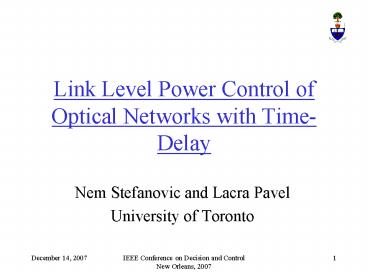IEEE Conference on Decision and Control - PowerPoint PPT Presentation
1 / 30
Title:
IEEE Conference on Decision and Control
Description:
Link Level Power Control of Optical Networks with Time-Delay. Nem Stefanovic and ... System - apply frequency domain stability analysis (Wang and Paganini,2001) ... – PowerPoint PPT presentation
Number of Views:47
Avg rating:3.0/5.0
Title: IEEE Conference on Decision and Control
1
Link Level Power Control of Optical Networks with
Time-Delay
- Nem Stefanovic and Lacra Pavel
- University of Toronto
2
- Pictures of EDFAs
3
Where/Why Use Optical Networks
- Backbone of Internet
- More bandwidth than any other communication
medium - No external electromagnetic interference
4
Optical Network Operation
- Signal channels carried by light
- Channels are wavelength division multiplexed
(WDM) - Network delivers signal from one end of network
to other - Light has a propagation delay
5
Components of Optical Network
- Optical fibers transmit light
- WDMs Multiplex Channels
- EDFAs amplify signals, introduce ASE noise
- Optical Cross Connects (OXC) reroute channels
6
Optical Network Links
EDFA
EDFA
OXC
EDFA
WDM MUX
WDM DEMUX
7
Optical Network System
- Inputs are signal powers at sources
- Outputs are optical signal to noise (OSNR) values
at receivers - Feedback returns OSNR value to sources
- Control algorithm at sources adjusts channel
powers for OSNR optimization
8
OSNR Model
ui(n) input power ith channel ?i,j jth
channel gain at ith channel output n0,i noise
at Tx
9
OSNR Optimization as Nash Game
- Each channel w/ action ui is a player in a game
- Each player minimizes their own coupled, cost
function
- Ui is a coupled utility function
- u-i is the u vector without the ith entry
10
Utility Function
- ai channel dependent parameter
11
Control Algorithm
?i tunable parameter at sources
12
Time Delay Example 1
- ?i,j time delay from source j to OSNR i
- ?i,B time delay from OSNR i to source i
13
SSSL Time Delay System
14
Example 1 Block Diagram
15
Closed Loop System
16
Problem Statement
- Determine the conditions for stability of the
closed loop system for all time delays ?i,j,
?i,B ? 0.
17
Research Context
- Single source single link results in general
communications (Z.Wang et. al., R. Johari et.
al., S. Deb et. al.) - no coupling in utility functions (Z.Wang et. al.,
J.T. Wen et. al.,T.Alpcan et. al.,R.La et. al.) - no study of time delay in optical networks
18
Time-Dependent Stability
For the following range of ai,
Closed loop stability is ensured given ?i
satisfies
19
Time-Independent Stability
20
Derivation of Results
- Modify control algorithm as function of
time-delay - Linear System - apply frequency domain stability
analysis (Wang and Paganini,2001) - Apply Gershgorins Theorem to exponential matrix
- Exploit shape of Nyquist plot
21
Nyquist Plot Details
22
Time-Dependent Simulation
Design 10 OAs cascaded, delay10ms, OSNR
targets?23dB
23
Future Research
- Tighten the sufficient conditions for stability
of closed loop system. - Include dynamic link pricing
- Razumikhin Theorem
- Krasovskii Theorem
- Extend OSNR model to include time-varying
parameters
24
Thank You!
25
Extra Slides
26
Channel Pricing Algorithm
- For pricing parameters ?i
- solve vi for OSNR target
- select all ?i 1
27
Time-Independent Simulation
28
Time-Dependent Simulation
29
Time-Dependent Instability
30
Time-Dependent ai Range
- Valid ai region for closed loop stability































